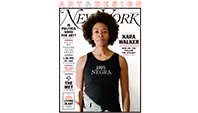 |
1. For New York’s “Art & Design” issue, Doreen St. Félix profiled Kara Walker nearly three years after her groundbreaking A Subtlety, or the Marvelous Sugar Baby propelled her into the public consciousness (“Kara Walker, After Subtlety,” April 17–30). The novelist Charles Finch tweeted, “Props to New York Mag for putting one of the five greatest living artists on its cover.” Culture Type’s Victoria L. Valentine appreciated how Walker “open[ed] up about the arc of her practice and the source of her obsession with America’s sordid race history.” Many in the art world were giddy at the specifics of Walker’s upcoming installations. Beckett Mufson at Vice’s Creators wrote, “Walker says she’s learned from her experience as an artist-cum-celebrity … and will bring that knowledge to two new public artworks this year.” For some, the news sealed travel plans: “Another sign all art-touring routes this summer should lead to Greece: Kara Walker’s installing on Hydra in June,” tweeted @TrifectaProject.
 |
2. After Boris Kachka’s examination of the mess at the Met surrounding director Thomas P. Campbell’s departure (“What Broke the Met?,” April 17–30), John Buchanan, who worked for one of Campbell’s predecessors, took issue with his contention that Campbell had democratized the museum: “It was democratized when Campbell was but a stripling by the brilliant director Tom Hoving (1967–1977), for whom I worked as chief registrar and special assistant to the director. How soon they forget.” Another past staffer, commenter CharmedImSure, emphasized how “intensely political” both the Met and the art world at large can be. “As a former employee who’s read all of this [coverage] both rapt and shocked, this is by far the best and most comprehensive. However, it only scratches the surface of the backstory … What’s been entirely overlooked so far is that everyone who’s been quoted … has an agenda and an ax to grind.” And commenter MetroMom thought the flaws with Campbell’s tenure were obvious well before his ouster: “The Met’s amateurish new logo encapsulates all that was wrong with Campbell’s reign. It looks like a high schooler designed it … From this article, it appears that every decision Campbell made was in the same tone-deaf mode.” Some readers, though, thought the headline was a little
too dramatic. @bklynharuspex tweeted, “ ‘Broke,’ really? The headline makes it sound like the doors are closed and pediments tumbling.” After all, despite the drama behind the scenes, commenter saxon212 pointed out, “it will always be my favorite place to spend a day off getting lost in the beauty of it all.”
3. “Red State, blue state? The urban-rural divide is more significant,” argued Justin Davidson (“Cities vs. Trump,” April 17–30), and many readers were inclined to agree. “The cities of the South are just like the cities everywhere else,” commenter OscarNYer wrote. “This is one of the great mysteries to people who don’t live in the South.” And commenter ThoughtfullyYour added, “As a Californian, I’ve seen the stark divide with the ‘liberal’ coastal communities on the left half of the state and the ‘conservative’ Central Valley on the right … One issue not mentioned in the article is the extent to which extreme right-wing groups have over the last century developed an ideology that is used to cater to the needs, desires and fears of rural communities in order to strengthen the power of the rich.” Others faulted Davidson for not addressing how race factored into this disconnect. Ernece B. Kelly of Riverdale took issue with Davidson’s characterization of Stuyvesant Town, “which he only talks about in physical terms, never mentioning its exclusion of blacks (ultimately leading to a lawsuit).”
4. “It pains me to say it, but I am a failed artist,” confessed art critic Jerry Saltz (“My Life As a Failed Artist,” April 17–30). His admission struck a chord with readers, especially those who are artists themselves. “I really needed to read this … I also fight self doubt everyday,” tweeted @gm3beats. “I just wanted to thank you for showing me … that sometimes pursuing what you love can work out even if it is not how we expect it to,” wrote 1timecommenter. Another commenter appreciated the (lackluster) review Saltz’s wife, Roberta Smith, the co–chief art critic at the New York Times, gave his work: “Wow. I gained a lot of respect for Roberta; her critique was brutal and unfortunately not far from the mark.” But a figure from Saltz’s artist past, Kit Smyth Basquin, wrote a letter to him shedding light on his so-called failure: “Your tri-part pastel drawings were in my Indianapolis Gallery in 1978. You were not a failed artist. Your background enabled you to see art with a keen eye. You could write, another talent. You chose between strengths. Writing makes you vulnerable too, as you say.”